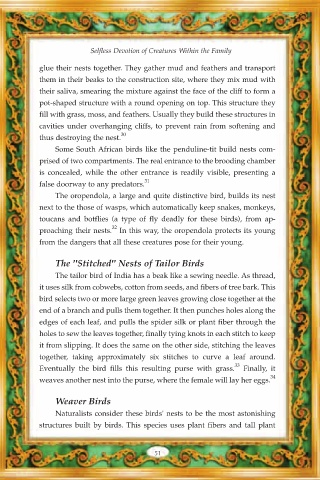Page 53 - Devotion Among Animals Revealing the Work of God
P. 53
Selfless Devotion of Creatures Within the Family
glue their nests together. They gather mud and feathers and transport
them in their beaks to the construction site, where they mix mud with
their saliva, smearing the mixture against the face of the cliff to form a
pot-shaped structure with a round opening on top. This structure they
fill with grass, moss, and feathers. Usually they build these structures in
cavities under overhanging cliffs, to prevent rain from softening and
30
thus destroying the nest.
Some South African birds like the penduline-tit build nests com-
prised of two compartments. The real entrance to the brooding chamber
is concealed, while the other entrance is readily visible, presenting a
31
false doorway to any predators.
The oropendola, a large and quite distinctive bird, builds its nest
next to the those of wasps, which automatically keep snakes, monkeys,
toucans and botflies (a type of fly deadly for these birds), from ap-
32
proaching their nests. In this way, the oropendola protects its young
from the dangers that all these creatures pose for their young.
The "Stitched" Nests of Tailor Birds
The tailor bird of India has a beak like a sewing needle. As thread,
it uses silk from cobwebs, cotton from seeds, and fibers of tree bark. This
bird selects two or more large green leaves growing close together at the
end of a branch and pulls them together. It then punches holes along the
edges of each leaf, and pulls the spider silk or plant fiber through the
holes to sew the leaves together, finally tying knots in each stitch to keep
it from slipping. It does the same on the other side, stitching the leaves
together, taking approximately six stitches to curve a leaf around.
33
Eventually the bird fills this resulting purse with grass. Finally, it
34
weaves another nest into the purse, where the female will lay her eggs.
Weaver Birds
Naturalists consider these birds' nests to be the most astonishing
structures built by birds. This species uses plant fibers and tall plant
51

